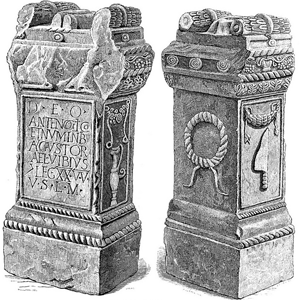
This page created 27 July 2014, and last modified: 14 December 2015 (RIB 1327 picture added)

The Seguntienses listed (98/9.88 in Ingo Maier's numbering scheme) in the Magister Peditum's infantry roster as a unit of auxilia palatina; it is assigned (102/5.100) to the command of the Comes Illyricum. Its shield pattern (95#2) as shown in various manuscripts under the matching label (95.b) Seguntienses, is as below:

The pattern is relatively simple, with a red rim and an indigo main ground (white in W, more purple in B, and faded to maroon in M and nearly to white in Ff); two curved crossed "figures" in red appear on the main ground, although what they may be trying to represent is hard to say. If I were forced to say, I would say they look like carnyces, although the tubes of these military instruments are somewhat straighter than what is shown on the Notitia pattern, and the bottom portion shown on the pattern curves the wrong way; so I would say they are nonetheless not carnyces. The closest I can come up with at the moment may be some sort of floral wreath-like decoration. Roman wreathes in circular form are well-known, but other forms existed, as can be seen from the altar (RIB 1327) set by a centurion from Legio XX Valeria victrix, and shown below.

This altar shows three different forms of wreathes; others may have existed. Alternative suggestions welcome!
Although there is evidence that many labels attached to the shield patterns illustrating the western auxilia platina have been shifted from their proper places, there is no evidence that this has happened to this particular unit; it would appear to be labelled with the correct shield pattern.
The name Seguntienses refers to Seguntium (Segontium, modern Caernarfon in Wales); presumably the unit was stationed there before joining the field army. No unit associated with the place appears an any of the British commanders in the Notitia: the Comes Britanniarum, the Comes litoris Saxonici per Britanniam; or the Dux Britanniarum. The only unit attested (RIB 430) at Segontium is the cohors I Sunicorum; whose name derives from the Belgic region of Gaul. Given the Roman habit of brigading units in pairs, it is notable that the next unit in the list of the Comes Illyricum, the Tungri (102/5.101), would also seem to not only have a British connection, in the form of the cohors I Tungrorum (154.24) and/or cohors II Tungrorum (154.28.1), but is also a unit whose origins lie in Belgic gaul.
Both the Seguntienses and the Tungri have palatine status in the Notitia, albeit very lowly ranked: presumably they would have had pseudocomitatenses status when they were first drafted away from Britain, and had been promoted in the meantime (the composition of the force under the Comes Illyricum seems to best fit a date after Stilicho's death, in 408, which would give plenty of time for this to have happened; it is a curious feature of the Notitia that no auxilia units are attested as having comitatenses status; they are all either pseudocomitatenses, or palatina).
1. Maier, Ingo; "Appendix 4: Numeration of the new edition of the compilation 'notitia dignitatum' (Cnd)"; last accessed 26 October 2015. See also for here for numbering examples. Return
2. Bruce, John Collingwood; "The Roman Wall: A Description of the Mural Barrier of the North of England", 3rd edition; Longmans, London (1867); at p 113, online version available here (last accessed 15 November 2015). Return
3. Burns, Thomas S.; "Barbarians within the Gates of Rome: a Study of Roman Military Policy and the Barbarians, ca. 375-425 A.D."; Indiana University Press, 1994; at p 192. Return

Return to the Notitia alphabetical unit list page.
Return to my Notitia index page.